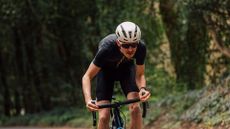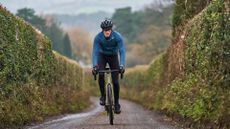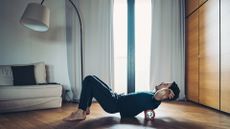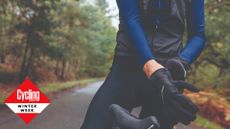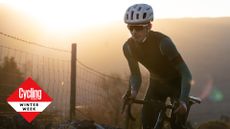Winter fueling: how to match your cycling nutrition to the demands of cold weather riding
Getting the most out of your winter training means making sure you are optimally fuelled for every ride - here's what you need to know about the specific demands of cold season nutrition
- (opens in new tab)
- (opens in new tab)
- (opens in new tab)
- Sign up to our newsletter Newsletter
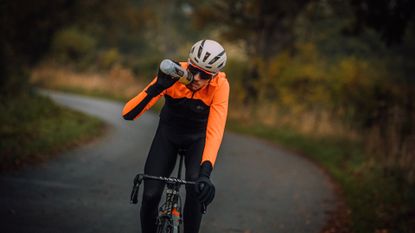

The days are getting shorter and the mercury is plummeting. Winter is here. Maintaining a consistent training load during the winter can be difficult. The cold, dark days envelop us in a battle with both the elements and motivation to cycle. As the weather worsens and your training load changes as you embrace winter routines, there is something else to consider beyond keeping warm and dry: Should your fuelling habits change too?
With fewer events on the calendar until spring – unless you’re a fan of cyclocross – most cyclists tend to reduce the intensity and focus on building their endurance base. With a switch to endurance cycling training, nutrition changes too. There is a tendency among cyclists to under-fuel on the bike, all year round. For endurance rides, the minimum recommended intake is 40g of carbohydrate per hour. So unless you’re deliberately limiting carbs (or calories) to burn fat whilst cycling or lose weight, then aim to eat the equivalent of two bananas per hour on the bike – it’s a useful rule of thumb.
Fueling for winter rides: how do requirements change?
It’s not all about carbs per hour. There are more considerations to account for when it comes to energy expenditure over the winter months. Many of us reduce our training volume, discouraged by the inclement conditions. On the other hand, training can become more energy-intensive owing to the nature of winter riding. Sports nutritionist David Starr (eatdrinkwin.com) explains:
“Extra clothing, stronger winds and higher rolling resistance can all make winter training a little harder than you anticipate. Very cold weather may increase your need for carbohydrates, if only because shivering is mainly carb-fuelled!” All of which highlight the importance of choosing well when buying key pieces of kit, such as a winter cycling jacket or winter bib tights.
For calculating your energy requirements, most modern cycling computers provide a good estimate of the energy you have used during a ride. It’s important to match your energy intake with your expenditure. ‘’If your intensity has decreased, then you will require less carbohydrate in your diet,” notes Starr, “but for many athletes training volume may increase so the overall amount of energy needed remains the same.”
There is no one-size-fits-all when it comes to planning cycling nutrition; it involves a little bit of planning. My personal technique is to estimate the duration and intensity of the ride. If it’s going to be three hours in Zone 2, I’ll take 150g of carbs – 50g per hour. I check the carbohydrate level of each product I’m taking, count them into my pocket and then always take one or two bars extra. You never know if you’ll drop a bar or end up tagging an extra loop at the end.
While keeping an eye on energy expenditure and intake it's important to ensure consistent training, it is better to be slightly over-fuelled than under-fuelled. My personal (admittedly crude) test to see if I have fuelled a ride correctly is to assess my hunger levels when I get home. Aim to consume a mixture of carbs and protein as soon as you arrive home – a protein shake is perfect. If I still feel like I could inhale the fridge, having downed my shake, then I know I haven’t eaten anywhere near enough during the ride. When that happens, there is usually a knock-on effect: the body’s equilibrium has been unsettled. This can become serious if you have multiple days of training to get through, especially with the added stress of the cold weather.
Winter nutrition and managing weight gain
Erring on the side of over-fuelling inevitably raises a question about weight. In our power-to-weight obsessive sport, it can be hard to put it out of our minds. We’re often a little heavier upon starting winter training, after the off-season, so it can be tempting to cut straight down and get back to ‘race weight’. Don’t fall into this trap.
“Race weight for elite athletes should be sustained only for a very short period in the season where they focus intensely on achieving a peak power to weight ratio,” clarifies Starr. “For the rest of the year, athletes are typically a few kilos heavier – which has benefits for their health and gives them some extra energy availability to help with adaptations to training.”
Personally, I try to avoid the scales in early winter training and only step back on them before my first fitness tests of winter, just to ensure we get accurate data. Weight is really not important at all over the winter. Though it is important to maintain a healthy lifestyle and diet, you do not need to be ultra lean. I’m content to be 5 per cent heavier over the winter months than in the race season.

Many athletes take supplements to help support their immune system in winter. While each individual has different personal requirements, best identified through a blood test of biomarkers (from the likes of Medichecks or Forth Edge), research has shown that all of us in the UK should take vitamin D. Being exposed to little intense sunlight, our bodies cannot produce enough of the ‘sunshine vitamin’ and need a little help. The recommended daily dose for sports people is 1,000iu of vitamin D3 (the sunlight-produced form), and make sure you choose an Informed Sport-accredited product, i.e. tested for banned substances.
Low carb fueling and winter training
Without any racing to worry about, many riders like to experiment with other fuelling strategies over winter, such as low carbohydrate training. If that’s an option you’re considering, first you need to think through the purpose and implications. “The most important thing to note is that low carbohydrate doesn’t mean fasting,” says Starr. “Having a protein-based breakfast, such as an omelette, with a small amount of carbohydrate, some fruit or vegetables, will support your training and help your body adapt appropriately to exercise, rather than breaking down muscle.”
Poorly planned low-carb rides may have a negative impact on your fitness, causing more harm than good. The strategy is intended to increase your body’s ability to burn fat as fuel, and therefore your training intensity should reflect this. Low-carb rides should be low intensity, typically Zone 2 Endurance rides and no longer than 90 minutes.
Turning from carbs to protein, because winter tends to be the season for doing more gym work, many riders increase their protein intake. However, there is actually more muscle damage from high-volume endurance training than from strength training, so your protein intake should be consistent throughout the year: 1.6-2.0g per kilogram of body weight each day. This allows the body to maximise the training adaptations while regulating the production of hormones to keep you healthy. Additionally, the body uses some protein as a source of energy on longer rides, so having plentiful supplies is win-win.
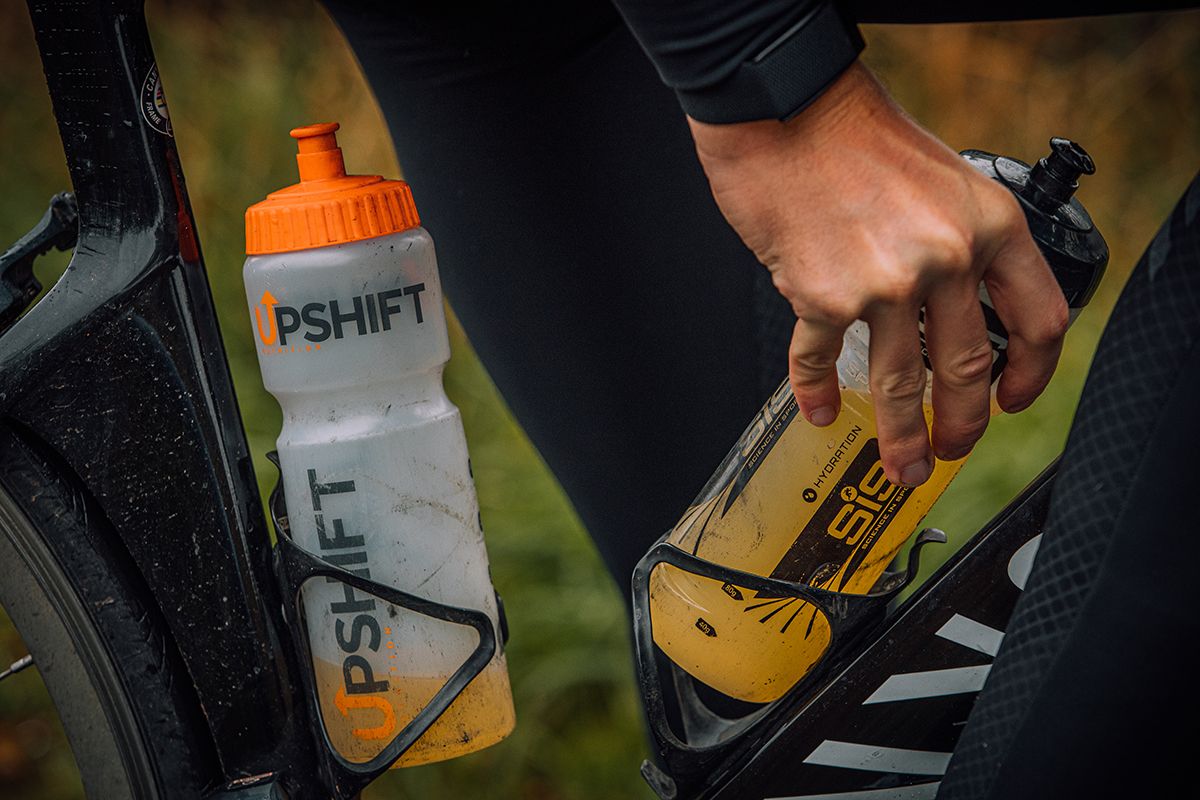
Winter cycling nutrition ideas
We asked sports nutritionist and chef Anita Bean to provide her favourite warming winter recipes – both are featured in her book The Vegan Athlete’s Cookbook: Protein-rich recipes to train, recover and perform:
Moroccan-Spiced Chickpea Soup
Bean says: This simple, protein-packed soup is highly nutritious and easy to make. Chickpeas are high in fibre, particularly a type called oligosaccharides that are fermented by beneficial bacteria in the gut. They produce short chain fatty acids that improve immune function and benefit your health in so many ways, including post-exercise recovery.
Serves 2
You will need.... 1tbsp olive or rapeseed oil 1 small onion, finely chopped 1 carrot, peeled and finely chopped 1 celery stick, finely chopped ½ tsp ground cumin ½ tsp cinnamon 1 tsp harissa paste 2tbsp tomato purée Salt and freshly ground black pepper 400ml vegetable stock 400g can chickpeas, drained and rinsed Juice of ½ lemon 50g baby spinach Handful of fresh coriander, chopped To serve: Toasted wholemeal pitta bread
Method
- Heat oil in a large pan over low heat. Fry onion, carrots and celery until onion becomes translucent -Stir in cumin, cinnamon, harrisa, tomato purée, salt and pepper an cook for one minute while stirring - Add stock and chickpeas, bring to the boil then simmer for five mins - Remove from heat. Using potato masher, mash some of the soup in the pan (not too much). Stir in lemon juice and spinach and let it cook in the heat of the soup for a couple of minutes until wilted. Adjust seasoning if necessary. - Divide between two bowls, sprinkle with coriander and serve with toasted pitta bread.
Per serving (including one wholemeal pitta bread): 489cals, 20g protein, 12g fat (1g saturates), 68g carbs (13g total sugars), 17g fibre
Chickpea and Butternut Squash Tagine
Bean says: This warming tagine made with chickpeas and served with couscous provides an excellent balance of essential amino acids that promote muscle recovery. Plus, it is a rich source of fibre, B vitamins and beta-carotene, an antioxidant vitamin that protects against cell damage during exercise. Spinach and dried apricots both add plenty of iron, while almonds supply vitamin E.
Serves 4
You will need 2 tbsp light olive or rapeseed oil 1 onion, finely chopped 2 garlic cloves, crushed 2cm piece fresh ginger, peeled and finely chopped 1 tsp ras el hanout or harissa paste ½ tsp ground cumin ½ tsp ground coriander ½ tsp ground cinnamon ½ butternut squash (approx. 500g), peeled, deseeded and cut into 1cm chunks 400g can chopped tomatoes 2 x 400g cans chickpeas, drained and rinsed 75g dried ready-to-eat apricots, roughly chopped Juice of 1 lemon 50g fresh spinach Salt and freshly ground black pepper, to season 50g flaked almonds, toasted A small handful fresh coriander, chopped To serve: Cooked couscous
Method
- Heat oil in a large pan over medium heat and cook onion for three mins until translucent - Add garlic, ginger, ras el hanout (or harrisa paste), cumin, corriander and cinnamon. Stir well and cook of one min. Add butternut squash, tomatoes, chickpeas and dried apricots and top up with enough hot water to just cover the vegetable. - Bring to the boil, then turn down the heat and simmer for 20-25 minutes unit the vegetables are tender. - Add the lemon juice and spinach, stirring until just wilted. Season with salt and black pepper - Scatter over the flaked almonds and chopped corriander and serve with cooked couscous (or quinoa if gf).
Per serving (including 50g – dry weight – couscous): 603kcal, 23g protein, 18g fat (2g saturates), 81g carbs (20g total sugars), 16g fibre
Nutrition for indoor cycling sessions
The combination of less daylight and riskier road conditions outdoors makes indoor training a more attractive option in winter. For those with busy work and family lives, these sessions are often squeezed in early in the morning or after work, and it can be easy to neglect nutrition at such times.
According to Dan Fleeman, director at Dig Deep Coaching and elite Zwift racer, it’s best not to panic-fuel in a hurry before your session. “Taking on carbs within the hour before starting, shortly after getting up, may cause hyperglycemia,” he explains. This is a spike in blood sugar above the optimum level. “Instead, either get up and eat two hours before your workout, or fuel on the bike during the warm-up.”
Similarly, when I was still in school and had to get my training done in the evenings, I was never sure whether I should eat dinner before or after my ride. Fleeman advises: “For evening sessions, athletes should have already taken on board two good meals during the day. A high-carb snack 90 minutes such as a large flapjack 90 minutes before the session should be sufficient. It’s also critical to keep drinking during the day, as you don’t want to start a session partly dehydrated.”
When the intensity is high, such as in a Zwift race, taking on some extra carbs is likely to benefit your performance even when the duration is relatively short, i.e. 30-75 minutes. If you’re going to be riding for an hour, aim to consume around 50g of carbs, in the form of either bars, gels or drink mix. Carbs are king when it comes to high-intensity training.
Dehydration may be less of a concern when riding outdoors in winter, compared to hot weather demands, but do bear in mind that your thirst may be suppressed when you feel cold. Though you won’t be sweating as much during winter rides, you’ll still be clammy under those insulating layers, and still losing water continuously through respiration – water vapour on your breath. Again, there is no one-size-fits-all rehydration schedule; find out what works for you and stick to it.

What is the ultimate indoor cycling hydration strategy? “The basic principles are in line with road riding,” says Fleeman, “but you need to pay added attention to fluid, as your sweat rate increases indoors.” Dehydration can be compounded over multiple days of drinking not quite enough, taking its toll on subsequent training, so it is important to keep topped up every day. Don’t ignore your thirst just because you’re distracted or busy; keep a big bottle of water close at hand – drinking enough throughout the day that your pee remains a nice light straw colour.
What’s best to drink while training indoors? “A good isotonic drink mix and gels work perfectly for high-intensity Zwift racing or training,” says Fleeman, “I would suggest a minimum or 60g of carbs per hour for intensive sessions and around 40g for endurance-based rides.”
There has been a recent influx of nutrition products designed specifically for indoor training. Does nutritionist David Starr think they have a place? “With the restricted air flow, and higher heat and humidity indoors, hydration demands are much higher,” he says. “SiS’s Turbo products seem to be cleverly designed to support these demands of indoor training.”
The ‘special’ ingredient in the SiS Turbo range is menthol, which is believed to have a cooling effect. Does it work? “There is not yet enough evidence to say for sure,” says Starr, “with a particular paucity of data for female athletes.” A recent study published in the European Journal of Sport Science found that menthol had no effect on either performance, perception of effort or thermal comfort. So if you want to keep cool, buy a bigger fan.
This full version of this article was published in the print edition of Cycling Weekly. Subscribe online (opens in new tab) and get the magazine delivered direct to your door every week.

Thank you for reading 10 articles this month* Join now for unlimited access
Enjoy your first month for just £1 / $1 / €1
*Read 5 free articles per month without a subscription

Join now for unlimited access
Try first month for just £1 / $1 / €1

Joe Laverick is a professional cyclist and freelance writer. Hailing from Grimsby but now living in Girona, Joe swapped his first love of football for two wheels in 2014 – the consequence of which has, he jokes, been spiralling out of control ever since. Proud of never having had a "proper job", Joe is aiming to keep it that way for as long as possible. He is also an unapologetic coffee snob.
-
-
 Closing the gap: David Gaudu emerges from Paris-Nice more confident than ever before
Closing the gap: David Gaudu emerges from Paris-Nice more confident than ever beforeThe Groupama-FDJ rider finished second overall at the Race to the Sun, but gained more than just the result
By Adam Becket • Published
-
 Goodbye lime: We need to talk about the Tour de France green jersey
Goodbye lime: We need to talk about the Tour de France green jerseyThere's change afoot at ASO's French races, with the combativity colour also undergoing a revamp
By Adam Becket • Published
-
 Everything you need to know about lactate: your burning questions answered by an exercise physiologist
Everything you need to know about lactate: your burning questions answered by an exercise physiologistFar from being an acidic waste product that makes your muscles burn, lactate is actually a vital source of energy. An exercise physiologist debunks the mistruths around the metabolite
By Tom Epton • Published
-
 Struggling on steep hills? New study finds dietary nitrate - as found in beetroots - helps to improve muscle torque
Struggling on steep hills? New study finds dietary nitrate - as found in beetroots - helps to improve muscle torqueAlready widely held as a ‘superfood’, could this be yet another string to the beetroot’s bow?
By Anna Marie Abram • Published
-
 7 benefits of riding outdoors - which you’ll miss out on if you train inside all winter
7 benefits of riding outdoors - which you’ll miss out on if you train inside all winterAs with most things in life, there is a balance to be struck…
By Andy Turner • Published
-
 Time to rethink your cycling goals? Here's how to set sustainable targets for the year ahead
Time to rethink your cycling goals? Here's how to set sustainable targets for the year aheadWe take you through a full spectrum of cycling goals - from fitness to sociability to adventuring - and how to chose one that will work for you
By Andy Turner • Published
-
 Get the best from a foam roller: exercises for cyclists
Get the best from a foam roller: exercises for cyclistsFoam rolling can aid recovery and stave off injury, we outline what muscle groups to focus on and how to ensure you’re reaping the benefits
By Nicole Oh • Last updated
-
 Suffering from numb feet or hands when cycling? Here's how to combat the cold
Suffering from numb feet or hands when cycling? Here's how to combat the coldYour extremities are the first to suffer when the temperture drops. Here's how to avoid painfully cold hands and feet
By Michelle Arthurs-Brennan • Last updated
-
 How to handle winter like a cyclist: your step-by-step guide
How to handle winter like a cyclist: your step-by-step guideThe season of weight training and nutritional debauchery is here
By Michelle Arthurs-Brennan • Published
-
 Ask a cycling coach: ‘If I can’t go on a bike ride, is it worth going running instead?’
Ask a cycling coach: ‘If I can’t go on a bike ride, is it worth going running instead?’Whether it’s a busy work/life schedule, a trip away from home or the dark winter evenings, there’s a host of reasons why fitting in a ride might be a struggle – but how good an alternative is running, really?
By James Spragg • Published


